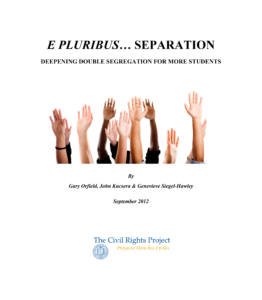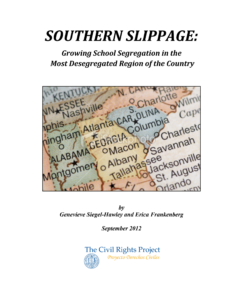Executive Summary
Amid historic shifts in Southern enrollment patterns, the black-white paradigm that long defined the South has shifted to what is now, without question, a multiracial one comprised of three large racial/ethnic groups. Together, black and Latino students account for about half of the region’s students, while whites constitute a minority.
The South remains the most desegregated region in the country for black students, but along every measure of segregation and at each level of geography, gains made during the desegregation era are slipping away at a steady pace. This report shows that the segregation of Southern black students has been steadily increasing since judicial retrenchment on Brown began in the early 1990s.
Though the Supreme Court granted desegregation rights to Latino students in the 1973 Keyes case, many Southern desegregation plans were dissolved without ever recognizing Latino rights. Latino students in the South were seldom included in desegregation orders, and have undergone steady increases in multiple measures of segregation over the past four decades.
Black and Latino students in the South attend schools further defined by double isolation by both race and poverty. The South reports high overall shares of students living in poverty, but students of different racial backgrounds are not exposed equally to existing poverty. The typical black and Latino student in the region goes to a school with far higher concentrations of low-income students than the typical white or Asian student.
In the following report, we present an in-depth treatment of Southern trends that are merely summarized in the accompanying larger report, E Pluribus… Separation. Key findings are highlighted below.
The South Becomes a Tri-Racial Region
- The South is a majority-minority region in terms of its school enrollment, second only to the West as the most diverse in the country. At more than 15 million students, the South has, by far, the largest enrollment of any region. Southern students make up almost a third of the national enrollment (32% of all students).
- Latino students account for nearly the same share (23.4%) of the region’s enrollment as black students (25.9%). At 46.9%, whites now constitute a minority of students in the South.
Growing Resegregation of Black Students
- Since 1991, black students in the South have become increasingly concentrated in intensely segregated minority schools (defined as 90-100% minority students). This represents a significant setback. Though for decades Southern black students were more integrated than their peers in other parts of the country, by 2009-10 the share of Southern black students enrolled in intensely segregated minority schools (33.4%) was fast closing in on the national figure (38.1%). By comparison, in 1980, just 23% of black students in the South attended intensely segregated schools.
- For the last four decades, contact between black and white students has declined in virtually all Southern states. In schools across the region, white students make up 30% or less of the enrollment in the school of the typical black student for the first time since racial statistics pertaining to schools were collected by the federal government.
- Most of the largest Southern metro areas also report declining black-white exposure. The Raleigh, NC metro had the highest black-white contact although this too has fallen in recent years. In 2009, the typical black student in the metro went to a school where whites accounted for about 45% of their peers, compared to about 54% in 2002).
- In 2009, black-white exposure in the metropolitan area of Raleigh was relatively similar to the overall white percentage in the metro (54%)–indicating fairly stable levels of desegregation. Future enrollment data for the Raleigh metro should be closely monitored to ascertain the impact of recent policy changes to the district’s voluntary integration policy.
- Two metros, Memphis, TN and Miami, FL, had the lowest exposure of black students to white students in 2009, under 15%.
Deepening Segregation for Latino Students, the South’s Fastest-Growing Minority Group
- The share of Latino students attending intensely segregated minority schools has increased steadily over the past four decades from 33.7% in 1968 to 43.1% in 2009; presently more than two out of five Latino students in the South attend intensely segregated settings.
- At the metropolitan level, Latino-white exposure is higher than black-white exposure across many major Southern metro areas. This is particularly true in Southern metros outside of Texas (where, in general, the lowest exposure between Latino and white students occurred).
- For example, Atlanta has a growing Latino student population, now comprising 13% of all students. As their share of enrollment has grown, Latino exposure to whites has fallen substantially—by nearly ten percentage points since 2002. Yet, Latino students in the Atlanta area still have higher exposure to white students (29.8%) than their black peers (20.3%).
- In ten Southern metros, the typical Latino attends a school where at least 40% of students are white. By comparison, only in the Raleigh metro did black students experience similarly high levels of exposure to white students.
Double Segregation by Race and Poverty in the South
- Black students experience the highest levels of exposure to poverty in nearly every Southern state. (This is different from the rest of the U.S., where Latino students experience higher average exposure to poverty.)
- Virginia, with the lowest share of student poverty in the South, also reports the lowest black exposure to poor students. Even then, almost 50% of students in the school of the typical black student in Virginia are low-income, considerably higher than the state’s share of low-income students (36.8%).
- Stark differences in exposure to poverty for white students, as compared to black and Latino students, exist in virtually every Southern and Border metropolitan area.
- In three Border metros, the typical white student attended a school with less than 30% poor students, and the typical black student attended a school with more than 60% of students from households at or near the poverty line.
We offer several region-specific recommendations to reverse the trends presented in this brief, including continued or new court oversight of Southern school districts, the development and enforcement of comprehensive post-unitary plans, and a strong commitment to pursuing voluntary integration policies.
Southern schools were at the epicenter of the civil rights revolution. From the l960s to the 1980s, schools in the region experienced a massive racial transformation that brought great increases in school integration. Those gains lasted for several decades, even as the region experienced a rising share of nonwhite students. Today, the South is in the midst of a two-decade long retreat from the goals of Brown. For Latino students, the region has consistently ignored the consistent uptick in their racial and economic isolation and, in essence, has turned its back on the fastest-growing group of students. If the South is to build an enduring and successful multiracial future, it badly needs to tackle new initiatives and policies to deal with the realities of a complex, deeply multiracial society where whites are one of several major minority groups.
This research by the Civil Rights Project includes an extensive report on national trends, “E Pluribus… Separation: Deepening Double Segregation for More Students,” as well as two smaller regional reports: “The Western States: Profound Diversity but Severe Segregation for Latino Students,” and this one, “Southern Slippage: Growing School Segregation in the Most Desegregated Region of the Country.”
In compliance with the UC Open Access Policy, this report has been made available on eScholarship:



